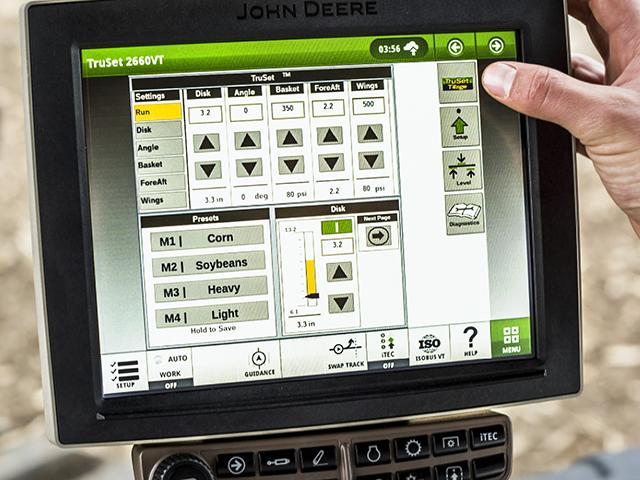Tillage Technology Boosts Efficiencies
Tillage Tech
Prescription tillage continues to grow in popularity among farmers as companies validate its value and equipment options expand.
Case IH and John Deere offer automated, prescriptive-tillage technology that's designed to increase productivity and profitability while also promoting land stewardship. Farmers can precisely tailor seedbeds based on agronomic and environmental conditions without manually making tillage tool adjustments.
Progressive Farmer first reported on the rise of prescriptive tillage in the January 2021 issue. Read the cover story at https://www.dtnpf.com/…
Case IH continues to conduct research studies and field demonstrations on its Advanced Farming Systems (AFS) Soil Command prescription tillage technology. John Deere decided to make its fully integrated TruSet Tillage technology standard equipment on most of its tillage tools and not an option. Both give farmers the choice to use prescriptions to automatically control tillage implements or do it manually.
"Prescription tillage is becoming more and more popular," says Ryan Jardon, John Deere go-to-market manager for large tractors and tillage. "The popularity has increased so quickly ... customers were asking for it on every tool. Farmers want to maximize production on the ground they have and be good stewards of the land."
CJ Parker, Case IH tillage marketing manager, says a small percentage of customers prescriptively till, "but it's definitely growing."
He adds that sales and use of technology will continue to increase "as more and more customers find out they have that ability and see the advantages."
TAILOR YOUR TILLAGE
Tillage prescriptions work on the same principle as other precision agriculture prescriptions farmers create for fertilizer and chemical applications, and planting. Prescriptions are written and uploaded to a tractor's computer, which automatically adjusts a tillage tool's settings as it is pulled across the field.
Adjustments could include the depth of shanks and disks, the gang angle of disks and the downpressure of wings and rolling baskets.
A prescription could call for more aggressive settings in areas of a field to alleviate compaction or slice, dice and bury crop residue. Weed control and leveling ruts could also require disks to run deeper or be angled more.
P[L1] D[0x0] M[300x250] OOP[F] ADUNIT[] T[]
In parts of a field with light, highly erodible soil, a prescription could adjust a tillage tool to be less aggressive or not engage with the ground to minimize erosion. More residue would be left on the surface.
"We have growers that want different things," says Alison Bryan, Case IH tillage research agronomist, referring to tillage outcomes. "A prescription can be simple or complex based on field needs. It can be based off of soil maps, topography, compaction and yield data to create different tillage zones."
PRESCRIPTION RESEARCH
Case IH has conducted on-farm conventional and conservation tillage research utilizing prescriptions to determine how the technology can help farmers.
A conventional tillage study Bryan led in March 2021 featured a Case IH Ecolo-Tiger 875 disk ripper pulled by a Case IH Magnum 340 tractor in several fields totaling 200 acres, near Elizabeth City, North Carolina. Each field was divided so half was ripped at a constant 14-inch depth, and the other half used a prescription to vary shank depth from 5 to 14 inches.
Extensive soil assessments were done, along with utilizing yield data, to write a prescription so shank points were 1 inch below compacted areas to eliminate it. "That's very important to producers since compaction can reduce yields 10 to 20% (or more)," Bryan claims.
Efficiency increased significantly with variable-depth prescription tillage compared to a constant depth, she adds.
"We saw a nearly 10% enhancement in productivity of acres tilled per hour since you could go faster in areas where tillage wasn't as deep. Less fuel was also used," Bryan says, though specific fuel savings weren't provided. "This is very valuable to growers when work windows are tight."
Bryan conducted a conservation tillage study in August 2020 in a hilly field with wheat stubble and highly erodible soil, near Racine, Wisconsin. A True Tandem 335 vertical tillage tool was used. A prescription was written to vary tillage depth from 0 to 2.5 inches depending on elevation, soil type, erodibility and yields. The goal was to prevent erosion where needed, manage residue and create a consistent seedbed.
"I get to show farmers the value of prescription tillage," Bryan continues, noting the conservation prescription worked as intended.
MOVING FORWARD
John Deere was the first company to offer prescription tillage technology in 2016. Its technology remains virtually the same. However, adoption has grown. The company not only offers TruSet Tillage technology as standard equipment on new tillage tools but also as an upgrade kit for older Deere rippers, vertical till machines and more.
"That's a testament to how steady the technology is and how much customers are embracing it," Jardon says. "It really gives farmers the opportunity to dial in a tool for what they want to do in a given spot."
TruSet requires a GreenStar 3 or Generation 4 in-cab display, and a GPS receiver. For non-Deere tractors, a Generation 4 4640 universal display is compatible.
Case IH dealer Redline Equipment, in Bowling Green, Ohio, held a prescriptive tillage demonstration for customers at a nearby farm in September 2020. Derek Hetrick, a Redline salesman and farmer, says attendees were mostly impressed with the technology as they watched a ripper and vertical tiller automatically make adjustments on the go based on prescriptions uploaded in the field.
"Farmers like the efficiency and consistent seedbed that will lead to better plant populations and even emergence," Hetrick adds. "That will help yield."
**
FOR MORE INFORMATION:
-- www.deere.com/en/tillage
-- www.caseih.com/northamerica/en-us/products/tillage
-- Follow the latest from Matthew Wilde, Crops Editor, by visiting the Production Blogs at dtnpf.com or following him on Twitter @progressivwilde
[PF_0222]
(c) Copyright 2022 DTN, LLC. All rights reserved.




